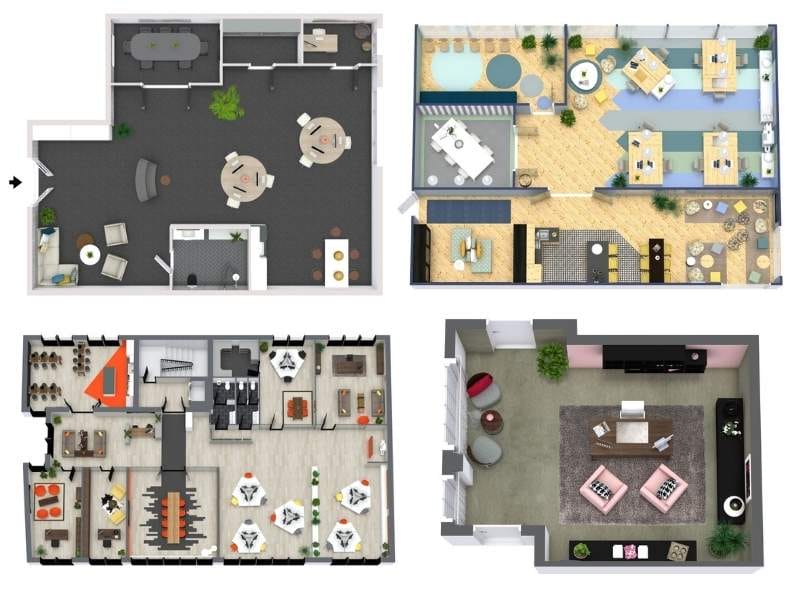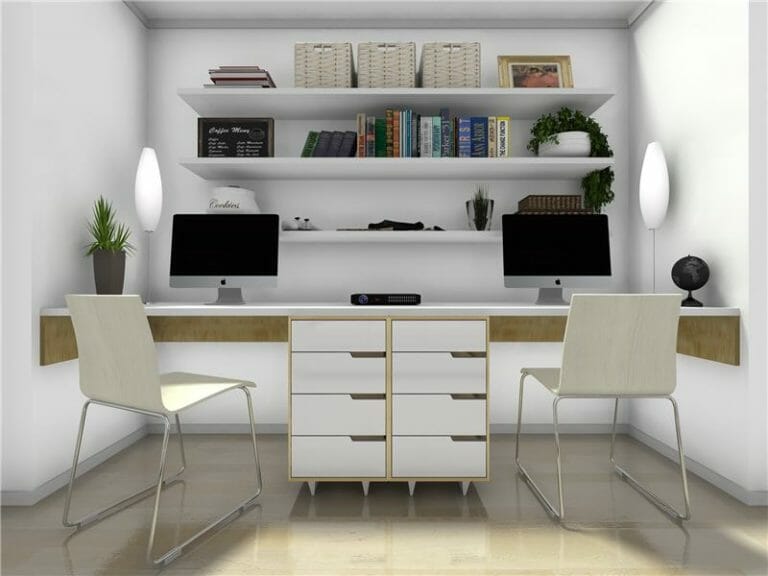Create a Functional Office Layout with These Key Measurements
As you plan your new office layout, it’s important to consider the space required around each piece of furniture. In this post, we’ll give you the information you need.

Planning your office layout? We’re here to help you create a workspace that’s comfortable, efficient, and looks great. In this guide, you’ll find the key measurements and smart tips you need to design an office that works for you.
When placing your office furniture, it’s important to give everything enough space to function properly. For example, file cabinets should have room to open their drawers all the way, so they’re easy to use and keep you organized.
Make sure the path from your office door to your desk is clear and wide enough to move through comfortably. With the right layout, you’ll create a smooth flow that supports productivity and makes your office a pleasant place to work.
So, how much space do you need around your furniture? Let’s take a look at our top tips for creating a layout that fits your space perfectly.
1. Desk Space Measurements

When you plan your office layout, give your desk plenty of room so you can work comfortably. Here’s what to keep in mind:
Standing desk size
- Width: 42"-80" (most commonly 48"-60")
- Depth: 24"-30"
- Height: Adjustable, typically 22.6"-50.9" for ergonomic flexibility
💡Recommended Desk Depth:
24"-30" is ideal for ergonomic reach and accommodating monitors and accessories.
Space between desks in an open office
Minimum space between desks:
- 23.6" (60cm) is the minimum for fire safety and basic movement
- 35.5" (90cm) is recommended for wheelchair accessibility and comfortable movement
Flow and movement aisles
- 35.5" (90cm) for single-person passage
- 59.1" (150cm) for two-person passage or main walkways
🪑Dynamic Chair Movement:
Allow 36"-42" (91-107cm) behind each desk for rolling chairs and ease of movement.
Overall desk-to-desk distance
- 78"-96" (198-244cm) is often the total distance between the centers of facing desks (including chair space)
Desk-to-wall distance in small offices
- 23"-25" (58-64cm) is the absolute minimum for a standard chair
- 30"-32" (76-81cm) is better for larger chairs or more comfort
- 33"-36" (84-91cm) is recommended for easy access to file cabinets or to allow for movement behind the desk
- For the most comfort and to allow someone to stand and move freely, about 40" (101cm) is ideal
Desk chair space
- Allow about 42" (107 cm) of space around a standard desk chair
- Reserve 20"-30" (50-76 cm) behind the chair. This lets you back up easily and reach bookshelves or a credenza without feeling cramped
Guest chair space

If you plan to have guests sitting in front of your desk, here's how to make sure it feels comfortable and inviting:
- Allow 48"-60" (122-152cm) in total for guests sitting in front of your desk
- Include 20"-30" (50-76cm) between the desk and the guest chairs
💡Accessibility and ADA Compliance:
Remember to consider wheelchair access, door widths, reachable heights for shelves and equipment, entrances (for example, elevators or ramps), and bathroom access.
2. Collaboration and Breakout Spaces

Modern office layouts are designed to encourage teamwork and creativity. That’s why you’ll often find open spaces where people can collaborate easily, from formal meeting rooms to informal breakout areas. For meeting rooms:
- A small meeting room (about 10'x10'or 3x3 meters) that seats 4-6 people should have 36"-42" (91-107cm) of clearance around the table
- Aim for 48"-60" (122-152cm) of clearance in larger meeting rooms around the table for an easy, spacious feel
- The presentation area should provide 48"-84" (122-213cm) of space so the presenter can move freely and engage with the audience
🪴Environmental and Wellness Considerations:
Incorporating elements that enhance the environment and wellness of the office helps boost productivity and overall aesthetics of the workspace. These could help:
- Plants
- Natural light and sunlight
- Water features: fountains or aquariums
- Organic shapes, patterns, and textures that mimic those found in nature: curved lines, fractals, or honeycomb patterns
- Other natural elements: natural materials like wood, stone, bamboo, and natural fibers
3. Safety and Emergency Exits

Make sure the office layout includes a clear evacuation plan. Having the proper space to make an emergency exit is crucial for the safety of everyone in the office.
Exit routes must be a minimum of 28" (70cm) wide and 7ft 6" (230cm) high.
4. Cultural and Organizational Needs

The type of organizational culture or specific work activities might influence layout decisions, such as open or closed offices and privacy needs. Will there be individual offices for each employee or an open layout? Doors or no doors? Screen dividers or fully open?
If you have an office space where people often have to walk behind or around you to get to where they need to be, for example, for meetings, remember to have enough space for them to move around you. You should have approximately 29.6” (75cm) clearance for this.
5. File Cabinets

File cabinets can take up to more room than you might expect. Make sure you plan enough space so they're easy to use:
- A standard vertical file cabinet (25" (50cm) deep) needs about 23" (58.5cm) of space in front to fully open the drawers and reach files at the back
- A standard horizontal file cabinet (20" (50cm) deep) needs about 18" (45cm) of space in front for easy file access
📂Storage Solutions Beyond File Cabinets:
- Modular storage
- Mobile pedestals
- Wall-mounted options
6. Bookshelf Space
Bookshelves are usually 12” (30cm) deep. To access books and binders easily, add at least another 12”-24” (30-60cm) for space to stand and move around.
7. Consider Flow of Movement

When creating your office layout, it's important to think about workflow. This means considering how you and others will move around the space. Write down your main office goals and the tasks you will do. Also, think about how you will move between the tasks. For example:
- If you go in and out of the room often during the day, make sure it is easy to get from your desk to the door.
- If clients or guests come to your office, the route from the entrance to the seating area is important for how people move around in the office.
- If you use an individual item, like a printer or a file cabinet, consider placing it within reach. For example, you could use a file cabinet/credenza behind your desk. If you do not use your printer or files often, you could place them across the room, with a clear access path.
✍️Pro Tip:
Use RoomSketcher to test different layouts and make sure your flow of movement actually works in real time. The Live 3D function lets you virtually walk through any layout you create.
How to Create a Great Office Layout

Ready to design an office layout that works? With the RoomSketcher app, you can draw, customize, and visualize your layout with precision. Try different layouts, test measurements, and make sure everything fits without moving a single piece of furniture.
Frequently Asked Questions
A well-planned office design is important because it improves productivity and has a positive effect on employees. The average adult spends over 50% of their daytime hours in an office, so the office layout must be functional. Use an office design software like RoomSketcher to plan your office layout.
Yes, the standard minimum width is 4 feet (1.2 meters) or 48 inches. The recommended width is 5 feet (1.5 meters) or 60 inches. For even higher traffic areas, it's recommended to have between 6 and 8 feet (1.8 and 2.4 meters) in width.
Here's how to do it:
- Identify the office layout and the type of workspace, such as open offices, private offices, cubicles, or meeting rooms
- Consider how people will move around the space
- Use standard clearance measurements and think about traffic patterns and accessibility needs
- Make adjustments based on the furniture and activities in the area
Using an office design software like the RoomSketcher App, you can easily design your own office space. We have a lot of videos and easy-to-follow help articles to get you started. Plus, our super-friendly Customer Service Team is ready to answer any questions you may have.

Need Inspiration?
Check our Floor Plan Gallery to:
- View office floor plans
- Open and edit floor plans in the RoomSketcher app
- Get floor plan ideas
- Visualize, label, and share with colleagues or clients
Recommended Reads

Plan Your Office Design With RoomSketcher
Plan and visualize your office design online and in 3D! Create layouts, floor plans, 3D images, source furniture and more with RoomSketcher.

5 Great Ideas for Small Office Floor Plans
Your office does not have to be big to be a perfect place in which to work. If you arrange the items in the room wisely, you can maximize the space you have.

9 Essential Home Office Design Tips
Planning a home office? These 9 essential tips will help you create a beautiful and practical home office design.
